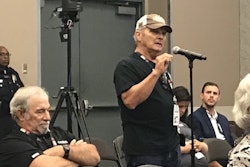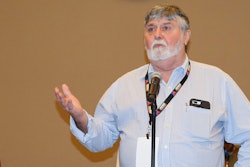
With a variety of hours of service revision options on the table in the wake of the Federal Motor Carrier Safety Administration’s Advance Notice of Proposed Rulemaking soliciting input from truckers and others — and the listening session regulators held at the Great American Trucking Show — everybody’s favorite subject of debate has engendered plenty among Overdrive‘s mostly owner-operator readers.
Commentary has been bookended on one side by the careful-what-you-wish-for set, including RC‘s cynical “big dreams” under James Jaillet’s report from the GATS listening session — “Get rid of HOS. No logs, no ELDs. Don’t need one in my pickup, why do I need any of it in my big truck? If I’m gonna fantasize, might as well dream big. I’m sure they will make changes that will make things worse.”
On the hopeful side, with no shortage of realism thrown in, was MrBigRigR504: “Drop the 30-minute break. Split the sleeper berth. [Add a] three-hour clock pause once a week…. Cool! Y’all keep in mind that shippers/receivers are watching and waiting to exploit any way they can to hold you with no detention pay and mess up your clock, then kick you off their property! And the rates will drop, also. HOS flexibility is one thing, but don’t make it easy for them to exploit our wiggle room and cut the rates! I’m just saying.”
The commenter’s proposal in a certain way splits (pun intended) the difference between two petitions that the FMCSA is considering around potential hours of service changes — the Owner-Operator Independent Drivers Association’s request for an at-least three-hour off-duty pause to the 14-hour clock that could be exercised when needed — and the Trucker Nation petition around liberalizing sleeper-berth splits, an option FMCSA has long been seeking to study.
Other commenters, however, such as Clinton Seals, pointed toward other ways to allow for some flexibility for owner-ops without giving rein to those who would abuse drivers’ time. Seals pointed back to a prior suggestion of a 16-hour window for completing a 14-hour duty day. “I feel this would eliminate a lot of our problems out here,” he said, offering what would amount to a daily possible two-hours’ worth of off-duty flex time for the 14-hour clock.
Butch McTavish favored a 16-hour on-duty window for the 11, and a required 8 hours off that could be run with splits “however you need to get rest and get the job done.” And Rick Schultz urged regulators to consider reverting to rules in place before the addition of the 14-hour window, including “unlimited use of split sleeper … however we see fit.”
Pat Hockaday, nonetheless, joined voices cautioning against allowing too much in the way of potential productivity with an eye on “the money,” as he called it. “We Drivers are honorable people for the most part. We could live with the HOS just as they are if only we could afford to operate in compliance! Are the LTL drivers crying for more ability to flood the market with capacity to lower their value? Don’t they drive for a living just as we? More is never enough for us, because we lower our value, making us need more.”
Hockaday, further, presented what he saw as a choice for truckload drivers: “Screw around with the HOS and remain stagnant for another 30 years” from a money perspective, or: “Fix the money and watch them try to fix the HOS to reduce our value for their profit!”
All around, given results of the prior round of hours of service listening sessions as the Obama administration came into play — which netted truckers the required 30-minute break and 34-hour restart restrictions that have since gone the way of the dinosaur — careful-what-you-wish-for cynicism is justified. But hopeful tones are, too, I’d wager. As above, you’ll find both in the selection of commentary below.
Commentary where it matters — on the regulatory docket in response to FMCSA’s requests — is open for a total 30 days to September 24, though requests have been made by at least one group, Trucker Nation, as of today to extend the comment period by 60 days.
Bill Austin: Saw a study decades ago that said that if people are isolated from time cues, they fall into a 25-hour day. No clocks, no view of outdoors to know the passage of time. That was used to show rotating shifts should move to the later shift each week, in effect sort of following that 25-hour day. The 14-hour day with a 10-hour break will always have drivers moving in the opposite direction. You’ll never use the whole 14, so you’re encouraged to start the next day at less than 24 hours, instead of 25.
Solution? What about 15 hours to get 12 hours driving in, followed by 11 hours off duty?
“Bigfoot”: The 30-minute break needs to disappear — to many of these young drivers sit in the fuel isles and make the rest of us eat up our clocks. It’s way out of hand, plus it messes up your schedule. A lot of times, you have enough time to get to the consignee or shipper, but say you’re short a half hour. So I have to stop somewhere to take a half-hour break and have the possibility of being late or using up time I don’t need to taking away from my day. I also feel we should have three more hours of drive time, which will let us have a 14-hour drive day with a five-hour on-duty time for an 18-hour day. Then add a bunch of sleeper berth break-ups in that time frame — this way a driver can rest as needed without pressure of forced sleeping
I’ve been operating for 27 years and have never once fallen asleep at the wheel. If I’m tired, I pull over and sleep, and with new sleeper berth splits that would be awesome.
Darren Zimmerman: I like getting rid of the 30-minute break. Splitting of the sleeper berth is a great thing also; having several appointment times in a day, because of our everyday circumstances (traffic, weather, deliveries and shippers), that’s where the splitting of the sleeper berth would be great so you do not have to reschedule appointments to make on- time deliveries and be able to progress to the next load.










